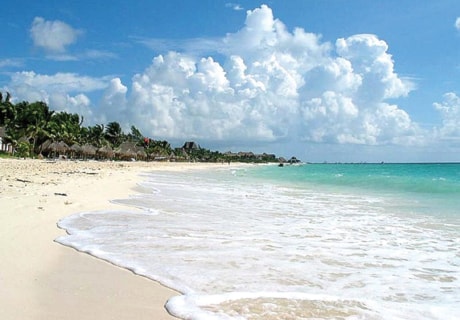TULUM, Mexico — The last time Bud Olson visited Mexico, he ended up in a hospital with kidney stones and missed the ancient Mayan ruins in the seaside town of Tulum.
So, when he heard that H1N1 flu was sweeping through Mexico just weeks before he was to return this year, the 43-year-old Seattle, Washington, resident and his friends threw all caution to the warm Caribbean breezes and went anyway.
Olson is one of the intrepid few who decided to come to Mexico in the throes of the epidemic.
His reward? No lines, great service, empty beaches — and lower prices.
“There was no one at our resort,” said Olson’s friend, Penny Moeller, 44. “The service was spectacular. But it’s a shame for the economy.”
Moeller says she ended up paying US$142 a week for a rental car she originally booked for $350.
Yes, it might just be the perfect time to head south of the U.S. border: Sure, the flu is still alive — in fact, it’s now a global pandemic — but chances of contracting it in Mexico, where the outbreak was first detected, are probably at their lowest.
The U.S. Centers for Disease Control and Prevention says that the epidemic peaked in Mexico in late April and now has spread throughout the Northern Hemisphere. The CDC says it will continue to be a threat south of the equator, where countries are entering the winter months and traditional flu season.
Mexican Health Secretary Jose Angel Cordova says the number of flu cases fell from an average of 300 a day during the epidemic’s peak to less than 30 now. “We don’t really have any more serious cases,” Cordova told The Associated Press.
The Mexican government has pumped US$91 million into getting that message out.
When the flu broke out, Mexico was already suffering from the economic crisis and fighting image damage over drug violence. Spring breakers still flocked to Mexican beaches far from the drug-plagued U.S. border, but thousands of tourists and businesspeople from around the world cancelled trips when the flu emerged.
President Felipe Calderon has recruited everyone from Mexican opera tenor Placido Domingo to Hollywood stars as part of the government’s “Vive Mexico” campaign to jump-start tourism, the nation’s third-largest source of legal foreign income.
Calderon recently met in Mexico City with actor Hugh Jackman, who “pointed out that our country is a healthy place for tourists,” the president’s office said in a news release.
Ben Stiller also has visited since the epidemic, despite being criticized for allegedly using anti-bacterial gel after shaking hands with Mexican reporters in Washington last month.
Stiller declared it all a misunderstanding and joked he liked Mexico so much he might even ask Calderon for a job.
So what will you get if you do decide to come?
Not the flu, according to several resorts that are backing that claim with a “flu-free guarantee.”
The Real Resorts Mexican hotel chain is among those offering one free vacation a year for three consecutive years — if guests come down with flu within 14 days of their departure and can produce the blood tests to prove it.
The chain also says it is discounting rooms up to 40 per cent and offering 50 per cent reductions on spa treatments, romantic beach dinners and liquor, as well as a “children stay free” deal.
“We have to show that we are free of this virus,” said Real Resorts owner Fernando Garcia Zalvidea. “We have to take risks so that tourism returns to our beaches.”
Nearly 300 Mexican hotels are participating in the “Biggest Hotel Sale Ever” campaign being offered by online travel agency Expedia Inc., according to company official Marco Tagliatti, who said that the average price for vacation packages to Cancun in which a flight and hotel are booked together has dropped 26 per cent compared to last summer.
With the weakened peso trading at 13 to the U.S. dollar, the destinations are also a deal for recession-weary Americans.
And if that’s not enough to persuade travellers to risk it, the Mexico City government is promising them free health insurance.
All of that fanfare was unnecessary for Olson, whose common sense told him he was more likely to catch a sunburn than the flu.
“I’m still convinced that it was an ordinary flu that the government and some press blew out of proportion,” he said.
Eva Litwinowich, 25, of Vancouver Island, arrived in Isla Mujeres, an island near Cancun, just before the epidemic broke out in April — and decided to remain even after her friend left early.
“I’m so glad I stayed because it’s not what it was built up to be,” she said as she trekked through the Mayan pyramids of Chichen Itza on the Yucatan Peninsula. “We met tonnes of people who also have come. I realized that not everyone was panicking.”
